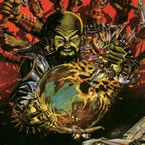Shark7
Posts: 7937
Joined: 7/24/2007
From: The Big Nowhere
Status: offline

|
Shameless self promotion. 
Original Post: http://www.matrixgames.com/forums/tm.asp?m=2727075&mpage=1&key=food�
We all know it, we all do it, and we all hate it...the dreaded colony rush. That burning need to grab every possible livable planet before some one else can get it. This is the one single thing that dominates almost every 4X game out there...how to grow as fast as possible, and it completely limits strategy.
The problem is that most 4X games simply assume that if you colonize a planet, it can produce enough food for your species...despite the fact that its as desolate as the Mars and hotter than Mercury. Sure our technology might allow us to build hydroponic facilities, but these will never produce enough food to support billions of people. Very simply put, you need fields of rich soil, plenty of water, and just the right temperature to grow enough food to feed an entire planets population. And colonies on less than ideal worlds would rely heavily on food imports.
Of course there are caveats. As the population of an ideal planet grows, its ability to produce food is diminished. The very land we need for housing is also essential for growing the food we need, be it grain or beef. Simply put, the larger the population grows, the more it compounds food shortage problems. Growing population has the double effect of reducing the amount of arable land to grow the food, and increasing the demand on the land that is available.
None of this is taken into consideration in any 4X game, at least not to the extent it should be. But I have an idea of how to do it.
1. We need a new resource type known as food. Not a general food category, but a number of different resources that all qualify. For examples:
Grain
Meat
Fish
Vegetation
Fungus
Bacteria
2. Each race would have to have a defined food need. Even mechanoids require energy and lubricants...IE they need 'food'.
Carnivore
Herbivore
Omnivore
3. Each race would have an ideal, acceptable and poor planet type for farming their food. For Shandar this would be a volcanic planet, while Humans need conitnental etc. This would require a simple table showing the colonizable planet types along with a 0 = ideal, 1 = acceptable and 2 = poor rating, example follows:
Race--------Continental---- Marshy----Desert----Ocean----Ice----Volcanic
Human..........0..............1.........2.........1.......2.........2
Securan........1..............1.........0.........2.......2.........2
Shandar........1..............2.........1.........2.......2.........0
etc
As you can see, I basically make 1 ideal, 2 acceptable, and 3 poor for each race in this example.
4. Planet productivity: This is going to be dependant on several factors. One thing I want to point out is that while some planets come with natural food sources (IE fauna), some of them require development. Also, not all the land of a planet is going to be farmable. At best, 50-60% of the land will be arable...more likely less, and the more population you have on the planet, the lower that percentage goes I'm going to break this down into several parts to explain my ideas:
A. Natural food sources: These exist on the planet at discovery. Planets can have 1 or all. These show up just like current resources do, and are gatherable via mining ships and stations. Examples per planet type.
Continental: Grains, Vegetation, Meats, Bacterial, Fungus, Fish
Marshy Swamp: Meats, Fish, Vegetation, Bacteria, Fungus
Ocean: Fish, Vegetation, Bacteria, Fungus
Desert: Meats, Fungus, Bacteria
Ice: Meats, Fish, Bacteria
Volcanic: Meats, Bacteria, Fungus
B. The food sources your race can develop. These are farms that develop much as the population growth does. Requiring time and I suggest it grow slowly. This is based on home planet type as well. Using the same table above, you get the idea....just because a planet does not have it at discovery, it can and will still develop the resource as your planet develops.
C. A check box on each planet that allows the player (and a set of default settings for the AI based on planet type, quality and size) that tells the game that this planet is designated an agrarian world to supply food to my population and capes the population at 33-40% of default max. So if a planet could support 10 billion population normally, then with it designated as agrarian it would max out at no more than 4 billion people. There also needs to be a policy that allows the player to set the parameters and have the AI auto-designate planets on colonization. This could depend on the arable land available: IE if arable land >= X units, then designate an agrarian world.
D. The arable land formula: Arable land = ((Planet size/2) * Quality) - (25 * Planet type modifier per species (0 for ideal, 1 for acceptable 2 for poor). Example 1 Planet Eden is a 400 size 100% quality continental colonized by the humans. So ((400/2) * 1) - (25 * 0) = 200 units of arable land. Example 2: Planet Oceana is a size 240 ocean planet of 80% quality colonized by the Shandar, so ((240 / 2) * .8) - (25 * 2) = 46 arable units. This planet can not produce a great amount of food and will likely need imports. Example 3: Planet Dystopia is a size 150 volcanic world of 30% quality colonized by the Sluken (for this example we will call it an acceptable planet), so ((150 / 2) * .3) - (25 * 1 ) = -2.5...since we can't have a negative, we simply call this 0. This planet will completely rely on food imports.
E. Population effects on arable land available. Too keep it simple, every 1 billion population would reduce the arable land by 5 units. So planets would see a reduction in food produced as their populations grow...and can get to the point where even a 100 quality large planet can require food imports due to using up all its arable land. IE a 100 quality, 400 size ideal planet that grows to 20 billion population looses 100 units (50%) of its food production capacity...this on top of an increased demand.
F. Food production and use. While those wiser than I would set the levels I will give you some quick examples (and how this ends up balancing in the end). Lets say each unit of arable land can produce 10 units of food. So a planet marked as agrarian that has 200 units of food (and will not grow about 40% of its population and is currently at 4 billion) will produce 2000 food units per unit of time (to be determined). Each 1 billion population requires 150 units of food per unit of time. The planet in the example produces more than it needs...it produces 2000 but only needs to use 600) so it can ship to other planets. Now lets say the population continues to grow...to 10 billion. Now this planet needs 1500 units of food per unit of time to feed the populace...reducing its exports to 500 units of food per unit of time.
This is all well and good, but we also have the capital planet that had only 170 arable units to begin with, and grew to 25 billion population, losing 125 of its arable units...leaving a total food growing capacity of 45 units or 450 units of food per unit of time...unfortunately it needs 3750 food, meaning it has to import 3300 food. So you need 2 agrarian worlds of limited population to support this one.
G. Obviously, technology would increase food production over time. A whole high tech tree could be developed for this.
5. If you run low on food for your populace they riot and rebel. The also begin to die off if it continues. In this way, it behooves you to develop your agriculture before trying to colonize non ideal worlds or to rush colonization.
You are probably wondering how this actually slows the colony rush. If done wrong, it doesn't, it just adds more complexity. If done right, where the arable land is developed into producing land is done at a very, very slow place it would. Basically, the speed of agricultural development needs to be at a rate that it takes years to fully develop the land and reach max production. The extremely slow farm development speed is key, if that is not present there is no point at all in implementing a system such as this. In other words, the availability of food would be the colony rush limiting factor.
Also, it doesn't have to be this in depth, it could be a simple 'food' resource and abstract it. Still the key is keeping food production development slow to limit the ability to grab additional colonies. One would need to develop farms before taking new planets. AI would limit by seeing if enough food is on hand.
And just because you have enough food for everyone, it doesn't mean you have it where you need it, you would have to devote more merchant ships to moving food. Logistics would act as a secondary limiting factor. Hungry colonist rebel, so going too far or too fast would result in losing control of the colony due to lack of food production or deliveries.
Its something to think about and discuss.
_____________________________
Distant Worlds Fan
'When in doubt...attack!'
|
 Printable Version
Printable Version





















 New Messages
New Messages No New Messages
No New Messages Hot Topic w/ New Messages
Hot Topic w/ New Messages Hot Topic w/o New Messages
Hot Topic w/o New Messages Locked w/ New Messages
Locked w/ New Messages Locked w/o New Messages
Locked w/o New Messages Post New Thread
Post New Thread